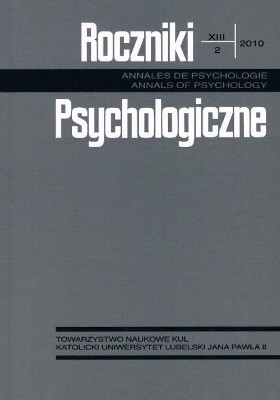Cechy samoświadomości a nasilenie symptomów depresji
Abstrakt
Niniejszy artykuł zawiera empiryczną analizę relacji pomiędzy samoświadomością a depresją. Prezentuje on wyniki badań grupy nieklinicznej (N = 76) oraz klinicznej pacjentów z diagnozą epizodu depresyjnego (N = 15). W badaniach wykorzystano Skalę Samoświadomości (Zaborowski, 1989) oraz kwestionariusz Center for Epidemiological Studies - Depression (Radloff, 1977). Celem badań była odpowiedź na dwa pytania. Pierwsze dotyczyło możliwości wyodrębnienia specyficznych konfiguracji opartych na charakterystykach samoświadomości, drugie zaś odnosiło się do możliwości powiązania otrzymanych konfiguracji ze stopniem nasilenia symptomów depresji. Analiza klasyfikacyjna dała podstawy do wyodrębnienia w grupie nieklinicznej trzech skupień różniących się istotnie zarówno poziomem wszystkich form samoświadomości, jak i nasileniem symptomów depresji. Ponadto okazało się, że profil samoświadomości skupienia o najwyższym wskaźniku depresji jest zbieżny z profilem samoświadomości pacjentów depresyjnych.
Bibliografia
Bernstein, I. H., Teng, G., Garbin, C. P. (1986), A confirmatory factoring of the Self-Consciousness Scale. Multivariate Behavioral Research, 21, 459-475.
Burnkrant, R. E., Page, T. J. (1984). A modification of the Fenigstein, Scheier, and Buss Self-Consciousness Scales. Journal of Personality Assessment, 48, 6, 629-637.
Carver, C. S., Scheier, M. F. (1987). The blind men and the elephant: Selective examination of the public-private literature gives rise to faulty perception. Journal of Personality, 55, 3, 525-541.
Csikszentmihalyi, M., Figurski, T. J. (1982). Self-awareness and aversive experience in everyday life. Journal of Personality, 50, 15-28.
Davies, M. F. (1996). Self-consciousness and the complexity of private and public aspects of identity. Social Behavior and Personality: An International Journal, 24, 2, 113-118.
Fejfar, M. C., Hoyle, R. H. (2000). Effect of private self-awareness on negative affect and self-referent attribution: A quantitative review. Personality and Social Psychology Review, 4, 2, 132-142.
Fenigstein, A., Scheier, M. F., Buss, A. (1975). Public and private self-consciousness: Assessment and theory. Journal of Consulting and Clinical Psychology, 43, 522-527.
Fleckhammer, L. (2004). Insight into the self-absorption paradox: The development of a multi-faceted model of self-conscious ruminative and reflective thought. Australia: Swinburne University of Technology; http://adt.lib.swin.edu.au/uploads/approved/adt-VSWT20050913.152247/public/ 02whole.pdf (16.05.2006).
Fromson, P. M. (2006). Self-discrepancies and negative affect: The moderating roles of private and public self-consciousness. Social Behavior and Personality, 34, 4, 333-350.
Hammen, C. (2004). Depresja. Modele kliniczne i techniki terapeutyczne. Gdańsk: Gdańskie Wydawnictwo Psychologiczne.
Hull, J. G., Levy, A. S. (1979). The organizational functions of the self: An alternative to the Duval and Wicklund Model of Self-Awareness. Journal of Personality and Social Psychology, 37, 5, 756-768.
Ingram, R. E., Wisnicki, K. (1999). Situational specificity of self-focused attention in dysphoric states. Cognitive Therapy and Research, 23, 6, 625-636.
Langer, E. J. (1993). Problemy uświadamiania. Konsekwencje refleksyjności i bezrefleksyjności. W: T. Maruszewski (red.), Poznanie. Afekt. Zachowanie (s. 137-179). Warszawa: Wydawnictwo Naukowe PWN.
Lyubomirsky, S., Nolen-Hoeksema, S. (1995). Effects of self-focused rumination on negative thinking and interpersonal problem-solving. Journal of Personality and Social Psychology, 69, 1, 176-190.
Martin, A. J., Debus, R. L. (1999). Alternative factor structure for the revised self-consciousness scale. Journal of Personality Assessment, 72, 2, 266-281.
Millon, T., Davis, R. (2005). Zaburzenia osobowości we współczesnym świecie. Warszawa: Instytut Psychologii Zdrowia PTP.
Moberly, N. J., Watkins, E. R. (2006). Processing mode influence the relationship between trait rumination and emotional vulnerability. Behavior Therapy, 37, 281-291.
Nasby, W. (1985). Private self-consciousness, articulation of the self-schema, and recognition memory of trait adjectives. Journal of Personality and Social Psychology, 49, 3, 704-709.
Nasby, W. (1989). Private and public self-consciousness and articulation of the self-schema. Journal of Personality and Social Psychology, 56, 1, 117-123.
Panayiotou, G., Kokkinos, C. M. (2006). Self-consciousness and psychological distress: A study using the Greek SCS. Personality and Individual Differences, 41, 63-93.
Pyszczynski, T., Holt, K., Greenberg, J. (1987). Depression, self-focused attention, and expectancies for positive and negative future life events for self and others. Journal of Personality and Social Psychology, 52, 5, 994-1001.
Radloff, L. S. (1977). The CES-D Scale: A self-report depression scale for research in the general population. Applied Psychological Measurement, 1, 385-401.
Ruiperez, M. A., Belloch, A. (2003). Dimensions of the self-consciousness scale and their relationship with psychopathological indicators. Personality and Individual Differences, 35, 829-841.
Seligman, M. (1993). Optymizmu można się nauczyć. Poznań: Media Rodzina.
Seligman, M. E. P., Walker, E. F., Rosenhan, D. L. (2003). Psychopatologia. Poznań: Wydawnictwo Zysk i S-ka.
Sęk, H. (2005). Psychologia zaburzeń afektywnych. W: H. Sęk (red.), Psychologia kliniczna (t. 2, s. 100-119). Warszawa: Wydawnictwo Naukowe PWN.
Trapnell, P. D., Campbell, J. D. (1999). Private self-consciousness and the five-factor model of personality: Distinguishing rumination from reflection. Journal of Personality and Social Psychology, 76, 2, 284-304.
Trudeau, K. J., Reich, R. (1995). Correlates of psychological mindedness. Personality andIndivid- ual Differences, 19, 5, 699-704.
Wood, J. V., Saltzberg, J. A., Neale, J. M., Stone, A. A., Rachimel, T. B. (1990). Self-focused attention, coping responses, and distressed mood in everyday life. Journal of Personality and Social Psychology, 58, 6, 1027-1036.
Wu, J. K.-F., Watkins, D. (2006). Testing competing factor models underlying the private self-consciousness scale with Hong Kong Chinese adolescents. Social Behavior and Personality, 34, 10, 1245-1258.
Zaborowski, Z. (1989). Psychospołeczne problemy samoświadomości. Warszawa: PWN.
Zaborowski, Z. (1994). Współczesne problemy psychologii społecznej i psychologii osobowości. Warszawa: Profi.
Zaborowski, Z. (2000). Teoria treści i form samoświadomości. Warszawa: Wydawnictwo Akademickie Żak.
Zaborowski, Z. (2001). Problemy psychologii życia. Warszawa: Wydawnictwo Akademickie Żak
Zaborowski, Z. (2002). Człowiek, jego świat i życie. Warszawa: Wydawnictwo Akademickie Żak.
Copyright (c) 2010 Roczniki Psychologiczne

Utwór dostępny jest na licencji Creative Commons Uznanie autorstwa – Użycie niekomercyjne – Bez utworów zależnych 4.0 Międzynarodowe.


